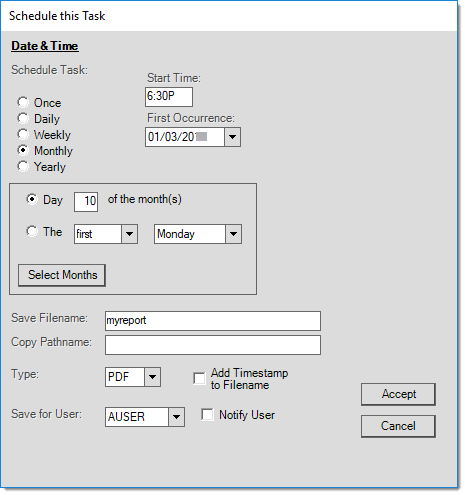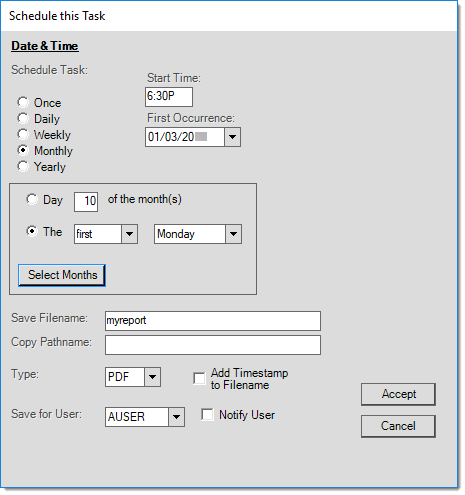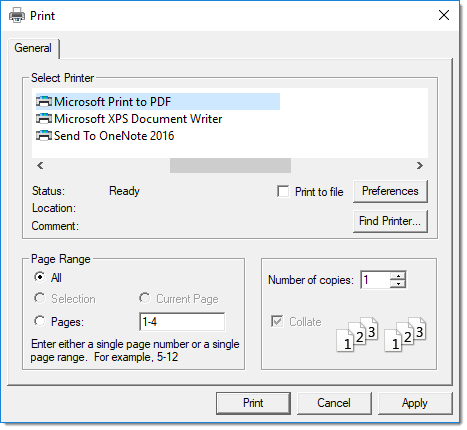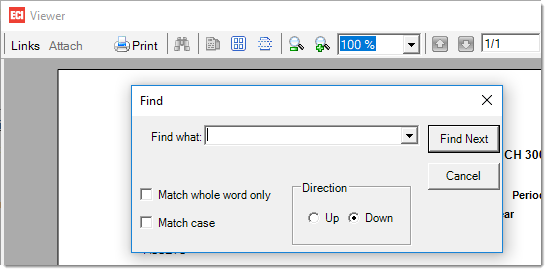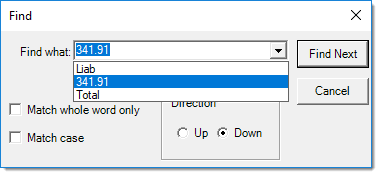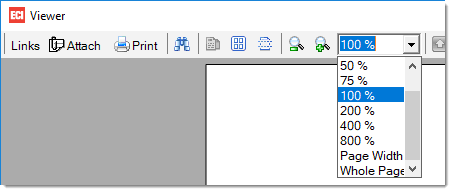This report lists your company's Chart of Accounts. A "chart of accounts" is a listing of all of the accounts that make up your company's General Ledger. Accounts listed (on the report) in bold text are accounts that don't maintain a balance and are used for providing summary totals for other accounts only. Posting accounts (accounts that can hold a balance) appear in normal text.
A chart of accounts is organized into a hierarchy of levels. There are 4 levels (or types): header, group, title, and posting.
1. Header accounts are the top most level and are required for providing totals for account classes such as assets, liabilities, expenses, etc. It is possible to use multiple header accounts with the same account class. For example, assets can be divided into "current" and "fixed," liabilities can be divided into "short term" and "long term."
2. Group type accounts are the next level below headers and are also only used for providing totals on financial statements. Groups might be used to separate totals for asset "inventory" from "receivables," for example.
3. Title accounts can appear below the group level but aren't necessarily used in every chart of accounts. Title accounts provide an optional additional level for totals if needed.
4. Posting accounts are listed either below the group or title totaling accounts. Posting accounts are the only account type that can hold a balance. The "owner" of the posting account is always either a group or title.
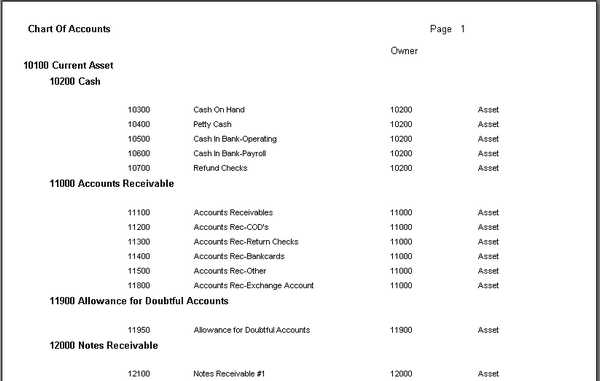
The report lists the account number (a number of different formats are available), account description, owner, and classification (assets, liabilities, expenses, income, etc.). The "owner" indicates the totaling account where that account's balance will be included on financial statements. Posting accounts are owned by either titles or groups, titles are owned by groups, and groups are owned by headers.
Selection
Currently, this report can only be created for the entire chart of accounts.
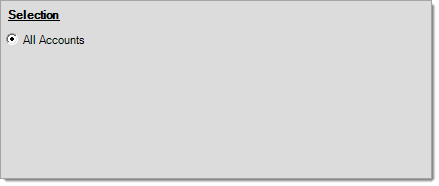
G/L Department
For some reports, a department selection option is provided. Departments can be used to indicate accounts for specific locations or any other purpose that's necessary. It's important to understand that by limiting the journal detail report to particular departments, the debits and credits on transactions will not necessarily match each other (because all accounts aren't necessarily included).
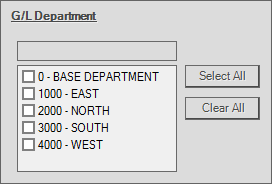
G/L Department
Department selection is disabled for this report.
Filter On
There are no filters available for this report.
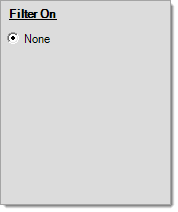
Sort By
Sort by selections are not available for this report.

Totals
A chart of accounts listing doesn't print any balances, just accounts, so there are no totals.
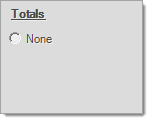
Print Options
Most reports share the same common print control. This allows the report to be either printed or saved as a file. When printing, a user can select either 1 or 2 printers and can also set the number of copies for each. When saving as a file, you can select from a number of different types (PDF, Microsoft Excel®, HTML, and TIFF). Neither printing nor saving as a file are required. These would only be done if you wanted to save a copy of the report and data for a given point in time. Certain types of activity and changes can affect data, including what is commonly viewed as "history," so anytime a "snapshot" at a particular point in time is desired, having a saved or printed copy is suggested. Reports are often also used for inquiry purposes. In many of these cases, viewing a report is sufficient. Printing and saving are optional unless you have a reason to do them.
The Process (F12) function is used to either print the report or generate a file. We suggest using the Preview (F8) function prior to printing or saving to ensure that the report results match what you want to print or save. The Viewer can also be used to print a report and provides the added ability to print only selected pages from a report.
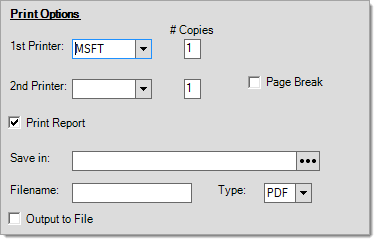
Reporting: Print Options
1st Printer and # Copies
The drop down control next to the label "1st Printer" provides a listing of available printers. An available printer is a printer that is either installed on your local machine or a server accessible printer if you are connected via Remote Desktop services (aka. Terminal Services). The default selection is the backroom printer assigned to the current station (if any). The listing of printers may contain devices that are specialty types, such as label printers, etc. that are not suitable for printing reports. This printer is only used if the "Print Report" check box is checked and the number of copies is greater than zero (> 0). Printing is not done until the user chooses Process (F12).
2nd Printer and # Copies
The drop down control next to the label "2nd Printer" also provides a listing of available printers (see above). This allows you to print a report at two (2) separate locations if desired. Even if a selection is made, the second printer is only used if the "Print Report" check box is checked and the number of copies is greater than zero (> 0). Printing is not done until the user chooses Process (F12).
Print Report
This check box determines whether printing is to be done if the user chooses Process (F12). The default selection is checked (true).
Save In
This is a text area with a browse button (...) that allows you to select a location where a report is to be saved as a file. Choose the browse button (...) to select an accessible location. This might be on a local machine or a shared network location of some sort. Saving (as a file) is not done until the user chooses Process (F12) and is only done if the "Output to File" is checked. Directory and file permissions can prevent you from saving files in some locations. It's best to choose a location you'll remember such as your "Documents" or "Desktop" locations.
Filename
This area allows you to set the file name you want to save the file with. The extension will automatically be set based on your selection from the "Type" drop down control. Saving (as a file) is not done until the user chooses Process (F12) and is only done if the "Output to File" is checked.
Output to File
This check box determines whether the report will be saved as a file when the user chooses Process (F12). The default selection is not checked (false).
Type
This determines the output format of the report when saved as a file. Choices currently include: PDF (Portable Document Format, .PDF), Microsoft Excel (Spreadsheet, .XLS), Hypertext Markup Language (Web Page, .HTM), or Tagged Image File Format (Fax, .TIF). The 97-2003 version of Microsoft Excel is used since it is forward compatible with newer versions. Free Adobe Acrobat Reader® software is required to access PDF format files. Any browser can be used to open HTML (HTM) files. TIF files is an older image format commonly used with faxing.
Functions
A number of functions are available with reports. Preview (F8) and Process (F12) are available with all reports. Others, such as those related to saving and scheduling, are available with many but not all reports.
Select (F5)
The Select (F5) function is used for choosing and loading previously saved report settings. Report settings can be saved using the Save (F6) function when applicable (report saving and selection is not provided for all reports).

Select (F5) Function
The "Select Report Settings" dialog offers a drop down control for report selection. Only public and the user's own private saved reports will be included in the listing. After selection, the report's associated description is displayed below. Click or choose "Accept" to continue and load the selected settings.

Select Report Settings
Deleting Saved Reports
A menu marker ![]() provides the ability to delete previously saved report settings. The menu marker only appears after report selection and if you have permission to delete the report. You can only delete a private report that you created or a public report. User security can restrict the ability to view or access menu marker functions. In addition, deletion may be restricted if the report settings are currently used with report scheduling.
provides the ability to delete previously saved report settings. The menu marker only appears after report selection and if you have permission to delete the report. You can only delete a private report that you created or a public report. User security can restrict the ability to view or access menu marker functions. In addition, deletion may be restricted if the report settings are currently used with report scheduling.
Save (F6)
This function is provided for saving the current report settings (selection, filter on, totals, branch, etc.) for future use or scheduling. The ability to save report settings is not provided for all reports. Additionally, users may have to make a change in the report form before this function becomes available (since there is usually no need to save the default or initial settings).

Save (F6) Function
Once all desired settings have been made and you have previewed the report to make sure it's what you need, choose Save (F6) to save your settings for future use or scheduling. Saved reports can be deleted (with certain restrictions) using the Menu Marker ![]() found on the Select Report Settings form (accessed by the Select (F5) function). See the "Deleting Saved Reports" section for more details.
found on the Select Report Settings form (accessed by the Select (F5) function). See the "Deleting Saved Reports" section for more details.
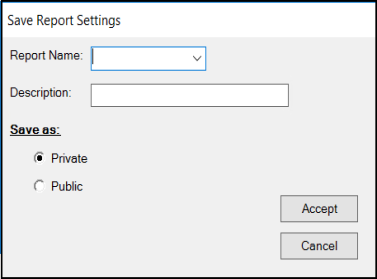
Save Report Settings
Report Name
This defaults to the name of the current report, but can be modified. The "name" will be used for selection in the future.
Description
The description also defaults to the current report's name, but can be modified. This might be used for longer or more descriptive information about the report.
Save As
The "private" and "public" options determine whether your report settings will be available for use by others in your company.
•Private
Private report settings are only visible to the user who created them.
•Public
Public report settings can be accessed by any user with permission to use the current report.
Schedule (F7)
The Schedule (F7) function is used to process a saved report (using previously saved "settings") as a file based upon a defined schedule (once, daily, weekly, etc.). Reports must be saved prior to scheduling so that settings for selection, totals, sort by, etc. are determined in advance. Scheduled reports are processed by application services and are saved as files on the server, not the user's local machine. A built in delay between reports of two (2) minutes (120 seconds) is used by services for processing scheduled reports. So if multiple reports are scheduled for the exact same time of day, it would be normal for there to be a difference in process times. Files with the same name and save location (directory) will be overwritten. The default directories (on the server) for scheduled reports and scheduled user reports are determined by parameters.

Schedule (F7) Function
Note: this function will only be available (enabled) AFTER and IF a report has been saved and the saved settings have been selected. Some reports do not support saving and scheduling.
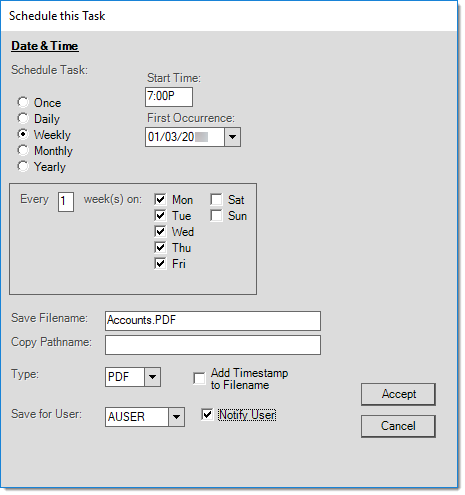
Schedule this Task
Frequency
It's possible to schedule a report to run once or on a more regular basis. Options include the following: once, daily, weekly, monthly, and yearly. The daily and weekly options change the file names used to prevent overwriting report files (continue reading for more information). For additional details regard frequency selections, click here
|
The following is a list of the different date based options for scheduling reports with examples of each form: Once Reports that are scheduled once, only generate one (1) time for the date and time specified. 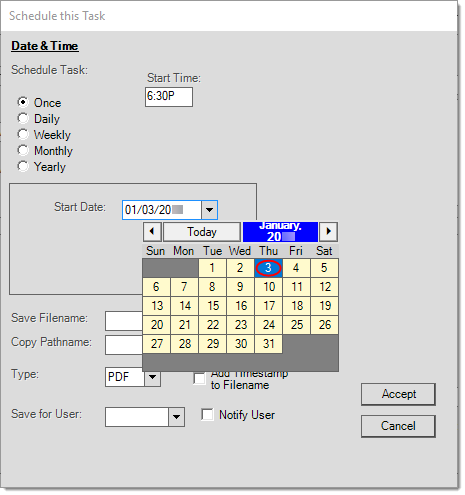
Schedule Task (Once) Daily Reports scheduled for daily processing, involve specifying a time as well as a starting date for the recurring schedule to begin on. In addition, there are three (3) choices for daily report processing: every day, weekdays, and weekdays plus Saturday. The day of the week is appended to the file name of the report to indicate the weekday (0=Sunday, 6=Saturday). For reports with date selections, only dates that involved a "preset" date selection will automatically refresh (update) the date selected; otherwise, the dates are assumed to be literal and are not updated based on the current date. For example, if you wanted to run a report daily and use the data on the date that the report runs, you'd need to choose a date preset of "Today" when saving the report settings used for scheduling. Instead, if you chose a specific date (not using the presets), the report would always run for that date instead. 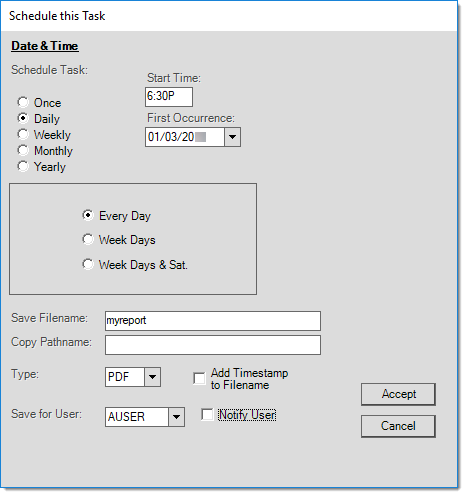
Schedule Task (Daily) Weekly Weekly reports can be scheduled to run on a particular weekday and time. In addition, the report may be set to run every week or using an increment of weeks (every 2 weeks or 3 weeks, for example). The base date (first occurrence) determines when the weekly schedule starts from. 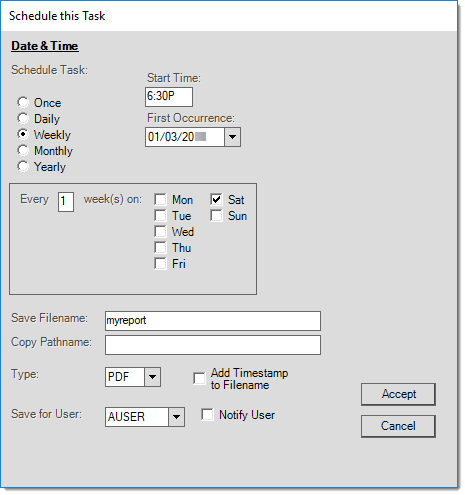
Schedule Task (Weekly) Monthly Monthly reports can be scheduled in one of two (2) ways. One option is to schedule the report to run the same day each month (the 10th, for example). Instead of a specific date each month, users can choose a particular weekday occurrence such as the first Monday or third Thursday, for example. Because months don't all contain the same number of days, a "Select Month" function is available that allows users to schedule a report for specific months. One possible use for this would be in cases where you wanted to schedule a report to always run the last day of the month. In this case, you could create three (3) different schedules. One for months with 31 days, another for months with 30 days, and a final one for February scheduling the report to run for the 28th (or 29th if a leap year).
Yearly The yearly option involves just a date and time selection. Users specify the start date and time and if scheduled, the report will run at the designated time and date. 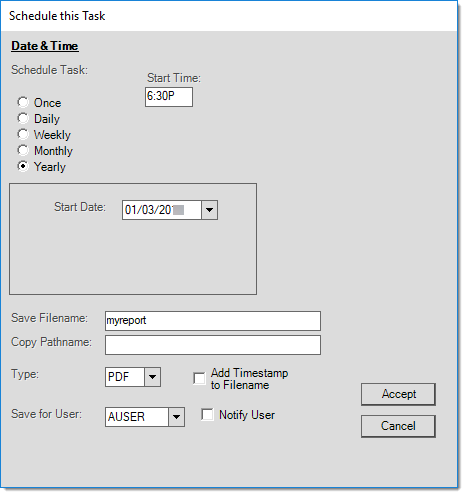
Schedule Task (Yearly) |
Start Time
The time of day (Eastern Standard Time) that the scheduler should process this report.
First Occurrence
The current or future date that the scheduled report should begin on. This might be a one time occurrence or it may repeat based on your "timing" selections in this form.
Save Filename
This is the file name that will be used. In certain cases, such as daily processing, the file name is used to indicate a day of the week.
Daily and Weekly Files and Naming Conventions
If a report is scheduled for daily or weekly processing and is being saved as a PDF format, the file name of the report will be automatically adjusted to reflect the day the file is created for. For example, if the report's file name is normally saved as mydailyreport.pdf, is scheduled daily, and run on a Monday, the file name is going to be mydailyreport(1).pdf. This prevents overwriting that would occur should the same file names be used daily. Weekdays are assigned numbers representing the day of the week. Sunday is day zero (0) and Saturday is day 6 (six).
myreport[0].PDF (Sunday's Report)
myreport[1].PDF (Monday's Report)
myreport[2].PDF (Tuesday's Report)
myreport[3].PDF (Wednesday's Report)
myreport[4].PDF (Thursday's Report)
myreport[5].PDF (Friday's Report)
myreport[6].PDF (Saturday's Report)
Copy Pathname
The "Copy Pathname" is optional and allows you to designate a secondary save location for the report. This allows two (2) copies to be retained. The same file name logic as described above is applied.
Type
This determines the output format of the report when saved as a file. Choices currently include: PDF (Portable Document Format, .PDF), Microsoft Excel (Spreadsheet, .XLS), Hypertext Markup Language (Web Page, .HTM), or Tagged Image File Format (Fax, .TIF). The 97-2003 version of Microsoft Excel is used since it is forward compatible with newer versions. Free Adobe Acrobat Reader® software is required to access PDF format files. Any browser can be used to open HTML (HTM) files. TIF files is an older image format commonly used with faxing.
Add Time-stamp to File Name
This feature basically makes the report file name unique and prevents any overwriting of the file by a future schedule run (such as in cases where you want to save a monthly copy but not overwrite each month).
Save for User
If a user is selected, the report will be saved in the "users" report directory within a folder matching the user's name.
Notify User
If checked, the user will be notified each time the scheduler processes this report.
How are reports saved and where do I find them?
The path names entered determine the primary, and optional copy, save location(s) of the file on the server within either (1) the report or (2) user report directories specified in Parameters.
"User" reports are created under a folder matching the user's name in the designated "User Reports" directory. For example, if your user name is BOBG and you schedule a report using the "Save for User" option and the "user report" directory in parameters is "C:\SavedReports\Users\," the following path would be used for BOBG's reports:
C:\SavedReports\Users\BOBG\
This directory could then be shared with the user's Client machine either as a shared network location or drive. It is not possible to specify a drive or network location as the path name. Doing so will simply create a directory on the server matching the name you entered.
The client must have any necessary software installed in order to open the file format you specify. For example, a PDF (Portable Document File) file requires Adobe Acrobat Reader software and an Excel (XLS or XLSX) spreadsheet requires Microsoft Office Excel or other software capable of opening the file.
Preview (F8)
The Preview (F8) function can be used to display a report in the Viewer form. Viewing a report is strongly suggested before choosing to either print or process a report as a file since this can be used to both see the printed length in pages and also to check the report format based on the options you have selected. In addition, reports can be printed directly from the viewer itself which also allows for the added benefit of printing only selected page or pages and well as additional options your printer may offer.

Preview (F8) Function
Each time preview is selected, the report will be generated which requires a retrieval of data. In some cases, and based on the criteria selected, you may be warned about the quantity of data being retrieved. Often, receiving a message such as this indicates that your report's selection criteria are too broad.
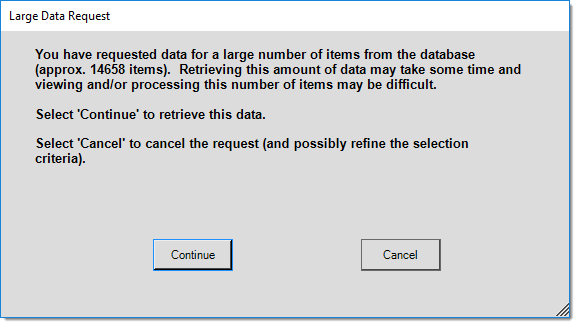
When should I save or print a copy of a report?
Despite the fact that most reports can be run at any time and usually for any period, the data used for reporting is rarely static. Anytime you want or need to retain a "snap shot" at a particular point in time, the only reliable way to do so is by saving the report as a file (PDF, etc.) or printing a hard copy for your records. Later changes such as merging, renaming or renumbering, deletions, and other changes can all affect whether data appears on reports or where it appears in some cases. For example, if you ran a sales analysis for inventory group 11 at the end of the year, and then modified one item in that group to now belong to 62, future reports would no longer show the same total for group 11 or 62. For the most part, changes such as those described here only affect data when viewed in parts rather than as a whole. Using our previous example, viewing total entire sales for all inventory wouldn't be affected by a change to one item's group at a later time.
Using the Viewer
The same viewer is used for both reports and documents. The primary different between viewing a document and a report is that reports don't have document links. Some reports offer dynamic links to documents (within the report) which indirectly provide access to links for those documents. The same viewer window is shared by reports and documents. When more than one report and/or document is viewed (without closing the viewer in between), the prior reports (or documents) can still be viewed by toggling the current document using the "PrevDoc" and "NextDoc" buttons. This is not true when viewing more than one version of the same report or document, however. Although you can change the page size and quantity of pages visible in the viewer (side by side or tiled, for example), you cannot view different documents (or reports) at the same time or side-by-side. The only way to do this would be to open a second viewer from another application session or to save one or more reports/documents prior to viewing and open them as PDF (Portable Document Format) or some other type of file.
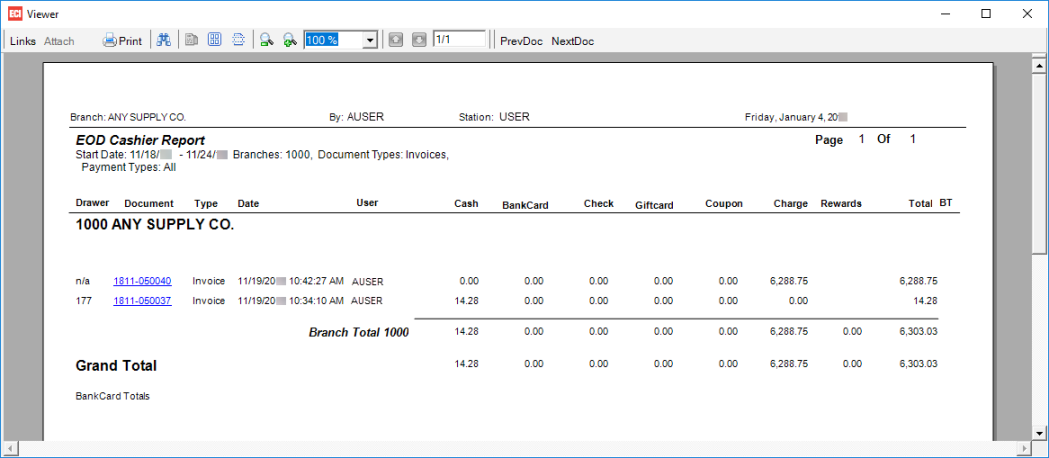
Viewer
For additional information about tools available in the viewer, please click here.
|
Document Viewer Toolbar The following table lists icons and options used on the Document Viewer toolbar and explains what they do:
|
Cancel (F9)
The Cancel (F9) function reloads the current form, clearing any changes.
Process (F12)
The Process (F12) function prints and/or saves the report as a file based on your selections in the Print Options panel.
